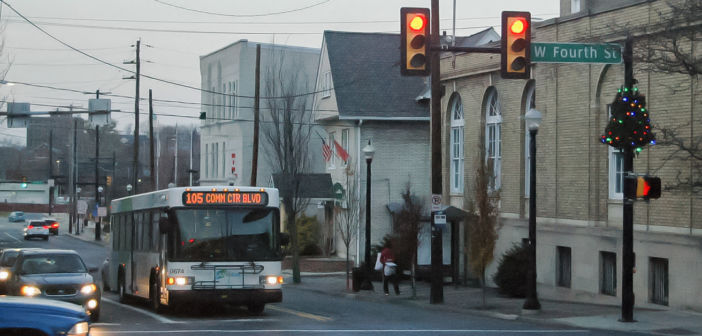Sister Teresa Rivera does not own a car. She lives in Bethlehem but takes the bus almost everyday to Allentown.
Rivera’s situation is not unusual in South Bethlehem. According to city-data.com, over 1,500 households do not have access to a car. About 1,247 South Bethlehem residents take the bus to work every day.
Within the city of Bethlehem, there are 333 public transit bus stops on 11 different routes. Two hundred and seventy of those stops are in North Bethlehem, while only 63 are in South Bethlehem.
North Bethlehem, the part of the city that ranges from the Lehigh River to Route 22, is geographically larger and has more than double the population of South Bethlehem, the area of the city between Fountain Hill and Hellertown. However, South Bethlehem might have a greater need for public transportation.
In 2012, according to city-data.com, 24.1 percent of the population in South Bethlehem reported an income below the poverty level. In North Bethlehem, only 12.5 percent of the population reported an income below the poverty level.
Brittnie Rodriguez, an Easton resident, uses LANta buses to commute everyday. While there is a bus stop close to her home in Easton, Rodriguez catches a ride to take the bus from the Bethlehem Fourth and New streets stop to Synchronoss call center.
“Easton’s a 30-minute drive from here, but catching the bus is like two and a half hours ’cause I have to get on three different buses,” Rodriguez said.
Lehigh and Northampton Transportation Authority, known as LANta, is the public entity that controls public transportation in Bethlehem. Not a government entity, LANta does receive funding from federal, state and local governments.
LANta provides public transportation with buses throughout Lehigh and Northampton counties, as well as the LANta van system.
During the 2016 fiscal year, LANta transported 4.92 million riders on its fixed route bus system. Approximately half of those riders were traveling to and from work.
Brendan Cotter, director of planning and development for LANta, said routes in urban areas, like downtown Bethlehem, have stops every 600 to 750 feet, or about every other block. An urban corridor area, which is slightly less densely populated with individuals and jobs, has stops every 750 to 1,000 feet.
LANta assesses the need for levels of service with the population densities — the people per square mile — and the employment density — jobs per square mile — that would really determine the level of service that goes to an area.
“If we’re more specifically talking about Bethlehem, an every-block scenario for bus access is more than adequate for the most part,” Cotter said.
Franklin Rodriguez, store manager of the Bethlehem C-Town supermarket, disagrees.
“I have a guy who lives in Allentown and he has to leave his house, if he wants to be here at 7 (a.m.), he has to leave his house at 5 or 5:30 in the morning just to be on time because buses will only bring you at a certain hour,” Franklin Rodriguez said. In a car, Allentown is about a 17-minute drive from Bethlehem.
Cotter said the authority is in line with industry standards for stop-spacing for transit authorities of like-size and similar density areas to the area LANta serves. By industry standards, if an individual is within a quarter of a mile walk from a transit stop, that individual is considered served by the transit authority.
“Certainly in the majority of the city of Bethlehem, a quarter of a mile radius around our bus stops, that pretty much covers at least the urban corridor of the city,” Cotter said.
In an area with a lack of cars, Cotter said LANta would consider the level of service in the area.
“An area that might not have a lot of individuals that have cars, and it’s densely populated, they might have more frequent service,” Cotter said. “So you get more service, but if you’re having a stop every other block, but you have really frequent service, it’s not as big of a deal to walk every other block.”
LANta changes service schedules three times per year, but the addition of stops is a constant review process.
Malinda Taylor, a South Bethlehem resident, does not think LANta has enough stops for the South Bethlehem community. She said a number of stops were taken away due to construction, and those stops are necessary for the community.
Rivera said she thinks the Bethlehem community needs more bus services.
“A lot of people want to travel on Sundays, and unfortunately there’s very few buses going on Sundays,” Rivera said. “So I think they should have more buses running on Sunday service. They really need it, bad.”
As for the disparity of stops on the different sides of the river, Cotter said road networks on the North Side and South Side are much different.
“From the perspective of the authority, it’s not like a clean cut that there’s less service or stops on the South Side,” Cotter said. “It’s that the geographic boundaries are much larger on the North Side based on what we’re looking at.”
According to city-data.com, 3.8 percent of people living in South Bethlehem choose to take the bus or a form of public transportation to work.
Evan Brown, manager of the South Bethlehem Subway said about six of the eight employees of the restaurant use LANta to get to work. There is a bus stop directly in front of the store.
Brown said it takes him about five minutes to take the bus from his home to work and he travels this way to work about half of the time. The rest of the time he walks. Brown said he finds the public transportation service in Bethlehem to be easy and convenient to use.
Charles Patrick, the owner of Molly’s Irish Grille & Sports Pub, said about two or three of his 25 employees use LANta to get to work, even though there is a stop directly in front of the pub. He said most Molly’s customers don’t use the bus either.
Although he does not use LANta, he knows many people who do.
“I know a good amount of people that do use it, and they seem to get to where they need to get to in reasonable time and fashion,” Patrick said. “I think they use it for everything. If they don’t have their own automobile, that’s their primary source of transportation.”






Comment policy
Comments posted to The Brown and White website are reviewed by a moderator before being approved. Incendiary speech or harassing language, including comments targeted at individuals, may be deemed unacceptable and not published. Spam and other soliciting will also be declined.
The Brown and White also reserves the right to not publish entirely anonymous comments.
1 Comment
Pingback: Bethlehem residents voice concerns about public transportation | Lifesia